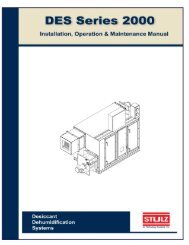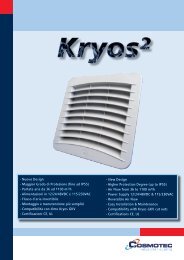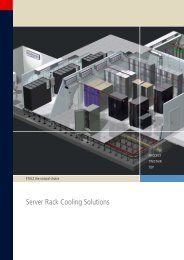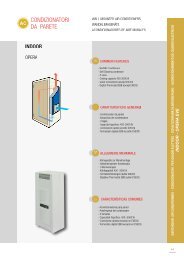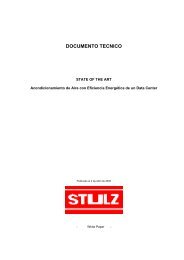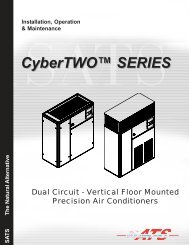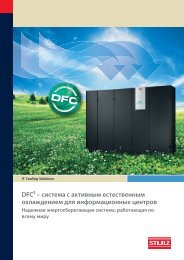Mini-Space Series Installation, Operation & Maintenance Manual
Mini-Space Series Installation, Operation & Maintenance Manual
Mini-Space Series Installation, Operation & Maintenance Manual
You also want an ePaper? Increase the reach of your titles
YUMPU automatically turns print PDFs into web optimized ePapers that Google loves.
<strong>Mini</strong>-<strong>Space</strong> <strong>Series</strong> <strong>Installation</strong>, <strong>Operation</strong> & <strong>Maintenance</strong> <strong>Manual</strong>3. Loosen the locking bolt on the side of the motorbase. Turn the jam nut away from the lockdownplate. Rotate the tension rod to move the motoron its’ base to release belt tension.BLOWER4. Remove the blower belt(s).5. Loosen the set screw in the side of the sheavewith an Allen wrench.6. Remove the sheave key.7. Adjust the blower speed by closing the sheaveone half turn to increase speed or opening thesheave one half turn to decrease speed.8. Replace the sheave key and tighten set screw.9. Replace the blower belt.10. Proper belt tension is achieved when the belthas a deflection of ¾ inch per foot of span with afi rm pressure placed on the blower belt betweenthe blower and motor pulley. Rotate the tensionrod to move the motor on its’ base to increase ordecrease belt tension. Retighten the jam nut andtighten the locking bolt on the motor base.CAUTIONIf the belt tension is too tight, it will cause prematureblower and/or motor bearing failure. Ifthe belt is too loose, the belt will slip and causebelt squeals and eventual belt failure.11. Restore power to system.TENSION RODADJUSTMENTFigure 14- Belt Drive BlowerADJUSTABLEPULLEYMOTORBASE LOCKINGBOLTJAM NUTLOCK DOWNPLATEMOTORBASE12. Check the current draw on the blower motor toensure it does not exceed the nameplate ratingof the motor.13. If current draw exceeds the nameplate rating ofthe motor repeat steps 1 through 12. If the motorstill draws too much current, slow the blowerdown by opening the adjustable sheave onehalf turn at a time until the motor current is at orbelow the nameplate FLA.14. Check the motor overload on the blower starterto confi rm its setting is correct for the FLA of themotor.2.10.6 Thermal Expansion Valve<strong>Mini</strong>-<strong>Space</strong> precision A/C units utilize a ThermalExpansion Valve (TEV). The TEV maintains constantsuperheat of the refrigerant vapor at the outlet of theevaporator by metering the fl ow of refrigerant into theevaporator. Superheat is the difference between therefrigerant vapor temperature and its saturation temperatureat a given suction pressure. By controllingsuperheat, the TEV keeps nearly the entire evaporatorsurface active while preventing liquid refrigerantfrom returning to the compressor. As a standard,superheat is factory set at 12-15°F and should notneed adjustment.2.10.7 Hot Gas Reheat (Optional)The hot gas reheat option incorporates a hot gasreheat solenoid valve and a hot gas reheat coil.Under normal operation when no reheat is required,the hot gas reheat valve is de-energized and hot gasfl o ws directly from the compressor discharge to thecondenser. When there is a call for reheat, the controllerenergizes the hot gas reheat solenoid valve.The hot gas reheat solenoid valve diverts hot gas tothe reheat coil, mounted directly downstream of theevaporator coil, before it travels to the condenser. Noadjustment to the valve is necessary.2.10.8 Snap Acting Hot Gas Bypass(Optional)The snap acting hot gas bypass system providessome modulated capacity control and freeze protection.The hot gas bypass system includes a dischargebypass valve that allows some hot gas from the compressordischarge line to pass into the evaporator coilin order to maintain a preset suction pressure.The snap acting hot gas bypass system also providesfreeze protection for the evaporator coil bylimiting the minimum refrigerant pressure, therebypreventing the surface temperature of the evaporatorcoil from dropping below 32°F.(©April, 2008)2-20Air Technology Systems, Inc.



